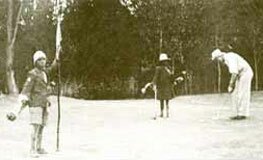Vaal Triangle History
1889 - 1902
1939 - 1945
1935
1960
Sharpeville
Klip Power Station
William Stow
Coal
Vaal Dam
Vereeniging Estates
Peace Negotiations
Viljoensdrift

he name Maccauvlei first officially entered the South African lexicon in 1844 when the area on the south bank of the Vaal River was bought from the Free State Republic government by a Voortrekker who rejoiced (or more likely brooded) in the name of Carel "Kwaai Augus" Pistorius. This formidable character had a particular mistrust of women and cheques. His mistrust of women, evinced by the fact that into his heavy wooden front door were carved the words "Women Deceiveth Ever", did not stop him from fathering six sons, who played an unwitting role in the Maccauvlei saga. History does not record Mrs Pistorius's view of men! Pistorius also purchased the farm Klipplaatdrift on the north bank of the Vaal, but built his house at Maccauvlei where he started farming sheep. The name itself came from a large wetland area populated by hippo and a wide variety of water birds including the magnificent spurwing geese, known as "Wilde Makoue". The area attracted some hunters in those early years including a young man named Paul Kruger.
Kwaai Augus trekked to Pietermaritzburg by ox-wagon annually to barter products such as biltong, salted butter and cured skins for cloth, sugar and coffee. On one of these trips he brought back some acorns which he planted in front of his veranda. The oaks flourished and were to play a pivotal role in the future of Maccauvlei although ironically, the timber for Pistorius' farmstead had to be brought up from the Natal capital by ox-wagon with great difficulty.
However, the destiny of Maccauvlei took another turn in 1878 when a pioneer geologist, George William Stow, prospecting on a commission from President Brand of the Free State Republic, discovered coal in the area. His initial find was opposite what is now Vanderbijlpark where the Taaiboschspruit meets the Vaal River. Floods over thecenturies had scoured away the overburden of clay to reveal a seam of coal.
Stow sank a shaft through 15 feet of solid coal, but an influx of water halted the operations. He then started test diggings at Maccauvlei and on the banks of the Leeuwspruit near where Sasolburg now stands, revealing even more extensive deposits. Stow realised that he had discovered a vast coalfield. But the Free State Republic government felt the discovery was of little value as the coalfields were too far from any major settlement to be viable, so Stow was paid off.
Stow sank a shaft through 15 feet of solid coal, but an influx of water halted the operations. He then started test diggings at Maccauvlei and on the banks of the Leeuwspruit near where Sasolburg now stands, revealing even more extensive deposits. Stow realised that he had discovered a vast coalfield. But the Free State Republic government felt the discovery was of little value as the coalfields were too far from any major settlement to be viable, so Stow was paid off.
Meanwhile an energetic young Russian born entrepreneur named Sammy Marks, who had come to South Africa via

Carel "Kwaai Angus" Pretorius's house at Maccauvlei. The heavy wooden front door bore the carved legend "Women Deceiveth Ever" - just one indication of how he aquired his nickname.
T
The Wild Geese

Britain in 1868, had arrived in the area. After a short spell as a smous, Marks went to Kimberley and soon became a prosperous diamond magnate in the firm Lewis and Marks, a partnership with his cousin Isaac Lewis. He heard about Stow's coal discovery in the Northern Free State and adjoining Transvaal and was quick to realise the importance of the find. He arranged to meet Stow and discuss the possibility of mining the coal and transporting it by barge down the Vaal River all the way to Kimberley.
The meeting between Marks and Stow resulted in the formation of the "Zuid Afrikaansche en Oranje VrystaatscheKolen en Mineralen Myn Vereeniging" in 1880 with the explicit aim of exploiting Stow's find. The name Vereeniging was subsequently given to the township declared by President Paul Kruger in 1889, although the first erven
The meeting between Marks and Stow resulted in the formation of the "Zuid Afrikaansche en Oranje VrystaatscheKolen en Mineralen Myn Vereeniging" in 1880 with the explicit aim of exploiting Stow's find. The name Vereeniging was subsequently given to the township declared by President Paul Kruger in 1889, although the first erven
Page 2
